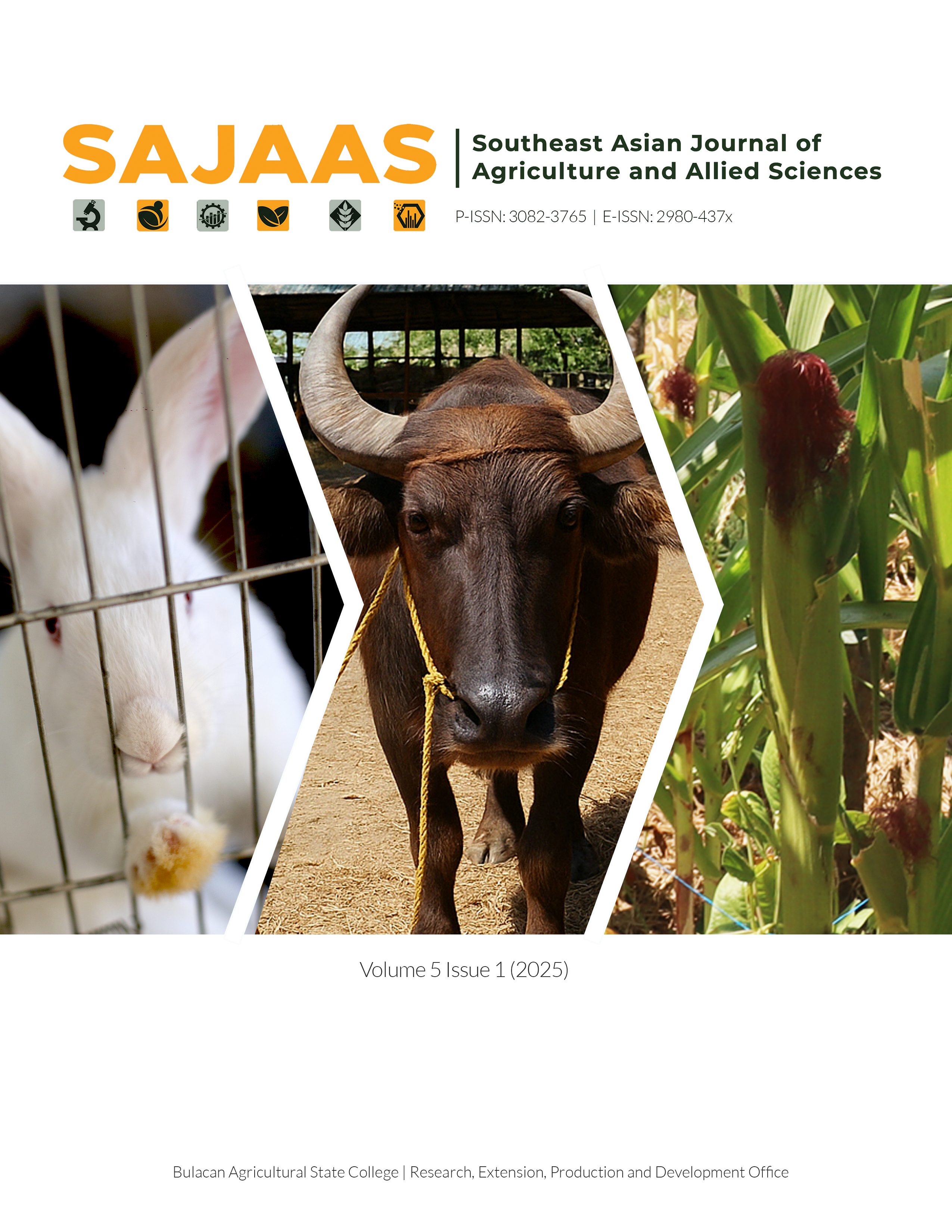Abstract
Crop suitability assessment is essential for land use planning, sustainable farming, and resource management prior to production. This research focused on the identification and re-delineation of soil types in the agricultural lands of Barangay Bantug, Science City of Muñoz, Nueva Ecija, and aimed to determine the suitability rating of the top five agricultural crops produced in the Philippines. With the use of the Handbook for Soil Series Identification in Nueva Ecija and the hydrometer method for soil texture determination of the surface soil (0–20 cm), six soil types were identified in Brgy. Bantug: Maligaya Clay, Maligaya Clay Loam, Maligaya Loam, Maligaya Silty Clay Loam, Maligaya Silty Clay and Bantog Clay Loam. The soil type map generated was used as land mapping units in crop suitability assessments of wetland rice, upland rice, corn, onion, mango, and sugarcane. In Maligaya Clay Loam and Bantog Clay Loam, all crops are potentially highly suitable. The permanent limitations from other land mapping units are basically related to the rooting condition, specifically the soil surface texture. The latest taxonomic classification based on secondary data indicates that the Maligaya Series is fine, smectitic, isohyperthermic, Typic Epiaquert, while the Bantog Series is very fine, mixed, isohyperthermic, Typic Endoaquert. The processes and maps used and produced from this research can benefit the local government unit in land use planning, the farmers in selecting crops to be produced, and future researchers in the identification and re-delineation of soil type maps for crop suitability assessment.
References
Agricultural Training Institute (2014). Baby Corn Production Guide. Agricultural Training Institute, Department of Agriculture, Republic of the Philippines
Bureau of Soils and Water Management (2013). Soil Type [Map]. Department of Agriculture. https://www.geoportal.gov.ph
Cañete, S. D., Collado, W. B., Badayos, R. B., Sanchez, P. B., Sta. Cruz, P. C. (2016). Suitability assessment of bantog soil series for potential enhancement of rice-based cropping systems. Philippine Journal of Science, 145(3), 237-247.
Collado W. B., Obico M. O., Dollentas R. T., Dela Torre J. P., De Dios J. L., Javier L. C., Quilang Jr. E. P., Badayos R. B., Soliman A. E. (2008). Simplified keys to soil series of Nueva Ecija. Philippine Rice Research Institute. Maligaya, Science City of Muñoz, Nueva Ecija.
Davis G., Casady, W. & Massey, R. (1914). Precision agriculture: An introduction. University of Missouri Extension. https://extension.missouri.edu/media/wysiwyg/Extensiondata/Pub/pdf/envqual/wq0450.pdf
Domingo A., Fiegalan F., Garcia F., Juico P., Mactal A., & Mason M. (2004). Laboratory manual: principles of soil science (SO 101). Department of Soil Science, College of Agriculture, Central Luzon State University.
Fiegalan, F. T., Juico, P. P., Mactal, A. G., Mason, M., & Perez, P. O., (2017). Soil Survey Classification and Land Use (SO 201): Laboratory Manual. Department of Soil Science, College of Agriculture, Central Luzon State University.
Food and Agriculture Organization of the United Nations. (1976). A framework for land evaluation (FAO Soils Bulletin No. 32). FAO.
Miura, K., Badayos, R., & Briones B. (1995). Pedological characterization of lowland areas in the Philippines. University of the Philippines, Los Baños, Laguna.
Ministry of Food Production of Trinidad and Tobago (2013). Fact sheet: how to grow field corn. Extension training and information services division in collaboration with research division.
Philippine Statistics Authority. (2016). Quickstat Nueva Ecija (monthly update of most requested statistics).
Ritung S., Wahyunto, A. F., & Hidayat H. (2007). Land suitability evaluation with a case map of Aceh Barat District. Indonesian Soil Research Institute and World Agroforestry Centre, Bogor and Nairobi.
Sys, I. R., Van Ranst, C. E., & Debaveye, I. R. J. (1993). Land Evaluation. Part III – Crop requirement (Agricultural Publications No. 7). Belgium General Administration for Development Cooperation. http://hdl.handle.net/1854/LU-233235
United States Government Accountability Office (2024). Technology assessment: Precision agriculture – Benefits and challenges for technology adoption and use. (GAO-24-105962) https://www.gao.gov/assets/d24105962.pdf

This work is licensed under a Creative Commons Attribution-NonCommercial-ShareAlike 4.0 International License.
Copyright (c) 2025 Southeast Asian Journal of Agriculture and Allied Sciences

